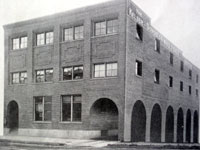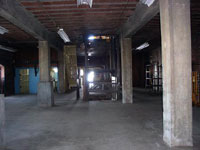| History |
| Comprising the 400 block of South Main St. in Mount Vernon, the Buckeye Candy & Tobacco Company building stands as the visual anchor of the downtown business district. Constructed in 1910 for the Kelser-Dowds Company, a |

The Kelser-Dowds building, as it appeared in 1910.
|
wholesale grocery firm, the building greatly impressed the town’s residents. This fireproof edifice boasted numerous technological advancements of the day, the most prominent of which was a hydraulic elevator that serviced its four floors. It was the preeminent regional firm from which to purchase grocery and sundry items wholesale, and it operated for almost sixty years under the Dowds family’s guidance. The demise of the business in the late 1960s reflected market trends at that time: national supermarket chains, which had their own independent distribution network, had gained substantial market share. This eroded the customer base, the small independent grocery stores, typically “mom-and-pop” operations, that had relied on local wholesale grocers like Kelser-Dowds.
Shortly after the building’s initial vacancy, the Buckeye Candy & Tobacco Company purchased it and began operating a wholesale business. Like its predecessor, the company was a family-owned operation that drew its customer base primarily from local, family-run operations. The Traces primarily sold candy and tobacco products, which they supplemented with a wide variety of paper products and supplies; they customized their product offering to reflect the needs of their diverse customer pool, comprised of service stations, small grocery stores, beauty parlors, barbershops, bars, and restaurants. Vending machines placed in local businesses and factories rounded out their offerings.
With mounting competitive pressure from regional and national distributors, coupled with the loss of customers to chain convenience stores and franchised restaurants, Tom Trace, the son of the company’s founder, auctioned off his inventory and sold the building in 2004, after thirty-five years of business at that location. Local businessman Mark Ramser purchased the property and offered the first and second floors to the Rural Life Center and the Local Food Council to support Food for Thought.
|
|
| Current Plans |
|
Initial Local Food Council discussions focused on using the building as a warehouse for local farmers’ products, possibly sharing the facility with the Food for the Hungry campaign. Subsequent discussions with farmers, coordinated by the Ohio State University Extension—Knox County, highlighted producers’ desire for a facility equipped to clean, package, and flash-freeze their products, as well as providing cold and frozen storage. An independent study project undertaken by several Kenyon students in spring 2005 considered using the space as a multifaceted facility, including a “for-hire” community kitchen and a retail sales area to house a year-round farmer’s market.
The Local Food Council became persuaded that the building was best suited for retail. One of the primary reasons is the building’s prominent location on South Main Street, the southern terminus of the business corridor’s economic revitalization. Additionally, the building would require extensive repairs in order to be functional for food processing and warehousing, and it would have limited ground-level space, compared to constructing a new metal building in an industrial park. Another significant deterrent is the potential for increased heavy truck traffic. Therefore, the Local Food Council determined to pursue the establishment of two separate facilities: a value-added processing and warehouse facility, to be known as the Knox Food Center, and a retail food space, to be located in the Buckeye Candy & Tobacco Company building.
| In March 2006, the Rural Life Center surveyed local food producers regarding their interest in the proposed facility. The survey expressed the purpose of this undertaking as being “to benefit artisan growers and producers seeking to value-add to their products, those interested in making and selling specialty/gourmet foods, and food preparers such as caterers, bakers, chefs, street-cart/kiosk vendors, and church, school and civic groups.”Those canvassed consisted primarily of the 2005 season participating vendors of the Market on the Square and the growers listed in HomeGrown: A Guide to. |

The large interior space of the Buckeye Candy & Tobacco Company building will provide adequate space for a kitchen and retail outlet for local foods.
|
Local Food Products in Knox County, Ohio Respondents overwhelmingly substantiated the desire for vegetable preparation and packaging, refrigerated storage, and flash-freezing, while adding egg cleaning and processing, food preparation, preserving, filling and packing.
During its spring 2006 meeting in April, the Local Food Council established a committee to investigate the retail use of the building. That committee is obtaining cost estimates and contractor quotations for a multitude of modifications and upgrades, specifying and pricing equipment alternatives, and developing strategies for making improvements and procuring equipment. The design includes a farmer’s market with vendor spaces operated by a nonprofit managing entity, a for-profit natural food store specializing in local foods, a for-profit café featuring local foods, and a nonprofit food cooperative.
|
|
